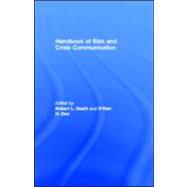
Note: Supplemental materials are not guaranteed with Rental or Used book purchases.
Purchase Benefits
What is included with this book?
| Exploring the Reach of Crisis and Risk Communication | |
| The Significance of Risk and Crisis Communication | |
| Historical Trends in Risk and Crisis Communication | |
| Cultural Theory and Risk | |
| Risk Communication: Insights and Requirements for Designing Successful Communication Programs on Health and Environmental Hazards | |
| Conceptualizing Crisis Communication | |
| The Precautionary Principle and Risk Communication | |
| Key Constructs of Crisis and Risk Communication | |
| Strategies for Overcoming Challenges to Risk Communication | |
| Risk Communication Education for Local Emergency Managers: Using the CAUSE Model for Research, Education, and Outreach | |
| Risk and Social Dramaturgy | |
| Myths and Maxims of Risk and Crisis Communication | |
| The Ecological Perspective and Other Ways to (Re)Consider Cultural Factors in Risk Communication | |
| Science Literacy and Risk Analysis: Relationship to the Postmodernist Critique, Conservative Christian Activists, and Professional Obfuscators | |
| Influence Theories: Rhetorical, Persuasion, and Informational | |
| Raising the Alarm and Calming Fears: Perceived Threat and Efficacy During Risk and Crisis | |
| Post-Crisis Communication and Renewal: Understanding the Potential for Positive Outcomes in Crisis Communication | |
| Risk Communication by Organizations: The Back Story | |
| Ethical Responsibility and Guidelines for Management Issues of Risk and Risk Management | |
| Linking Public Participation and Decision Making through Risk Communication | |
| Warming Warnings: Global Challenges of Risk and Crisis Communication | |
| Risk, Crisis, and Mediated Communication | |
| Crises and Risk in Cyberspace | |
| Virtual Risk: The Role of New Media in Violent and Nonviolent Ideological Groups | |
| Community Building through Risk Communication Infrastructures | |
| Contexts of Crisis and Risk Communication | |
| Crisis and Emergency Risk Communication in Health Contexts: Applying the CDC Model to Pandemic Influenza | |
| How People Think about Cancer: A Mental Models Approach | |
| Killing and Other Campus Violence: Restorative Enrichment of Risk and Crisis Communication | |
| Denial, Differentiation and Apology: On the Use of Apologia in Crisis Management | |
| Risk Communication and Biotechnology: A Discourse Perspective | |
| Precautionary Principle and Biotechnology: Regulators Are from Mars and Activists Are from Venus | |
| Environmental Risk Communication: Responding to Challenges of Complexity and Uncertainty | |
| Knowing Terror: On the Epistemology and Rhetoric of Risk | |
| Magnifying Risk and Crisis: The Influence of Communication Technology on Contemporary Global Terrorism | |
| Opportunity Knocks: Putting Communication Research into the Travel and Tourism Risk and Crisis Literature | |
| Table of Contents provided by Publisher. All Rights Reserved. |
The New copy of this book will include any supplemental materials advertised. Please check the title of the book to determine if it should include any access cards, study guides, lab manuals, CDs, etc.
The Used, Rental and eBook copies of this book are not guaranteed to include any supplemental materials. Typically, only the book itself is included. This is true even if the title states it includes any access cards, study guides, lab manuals, CDs, etc.